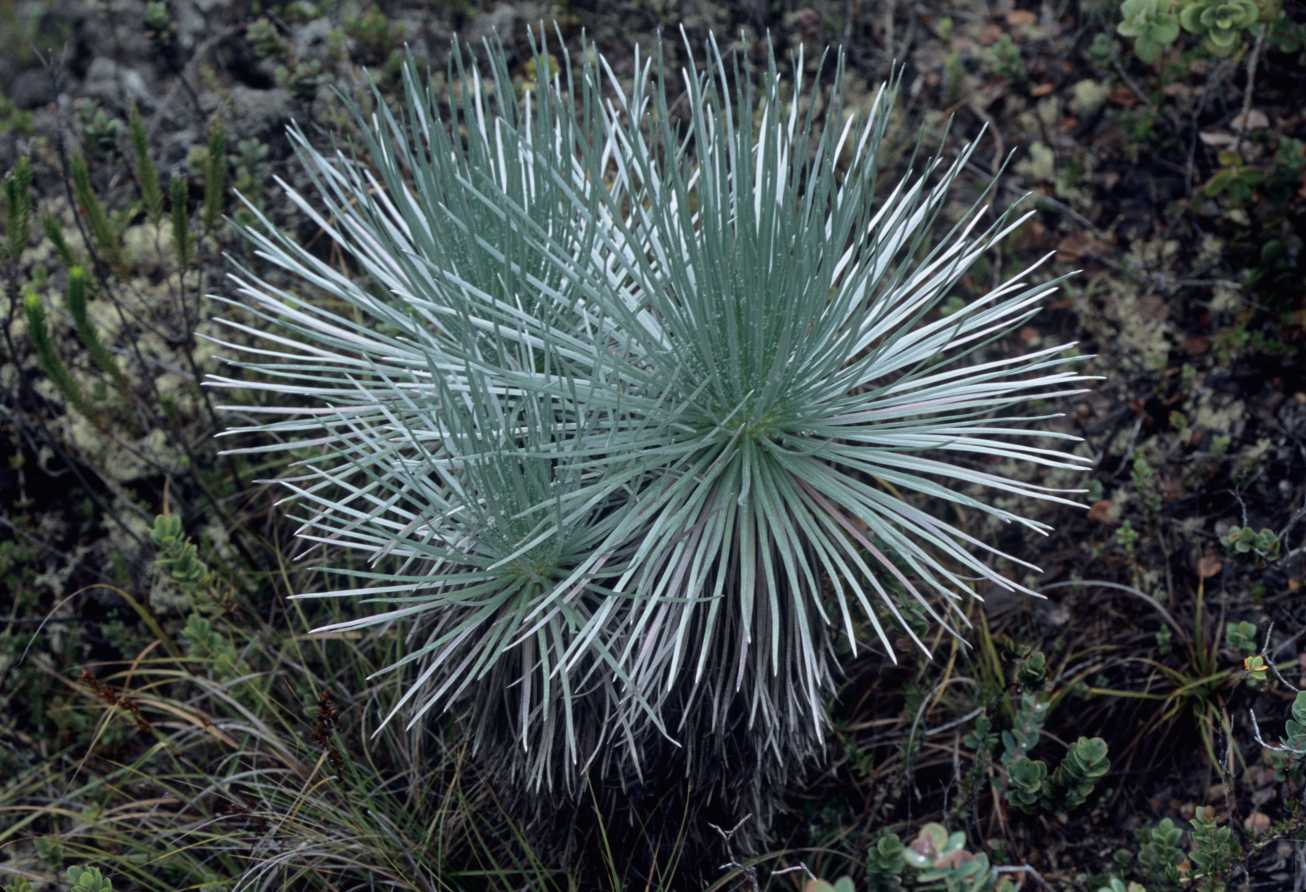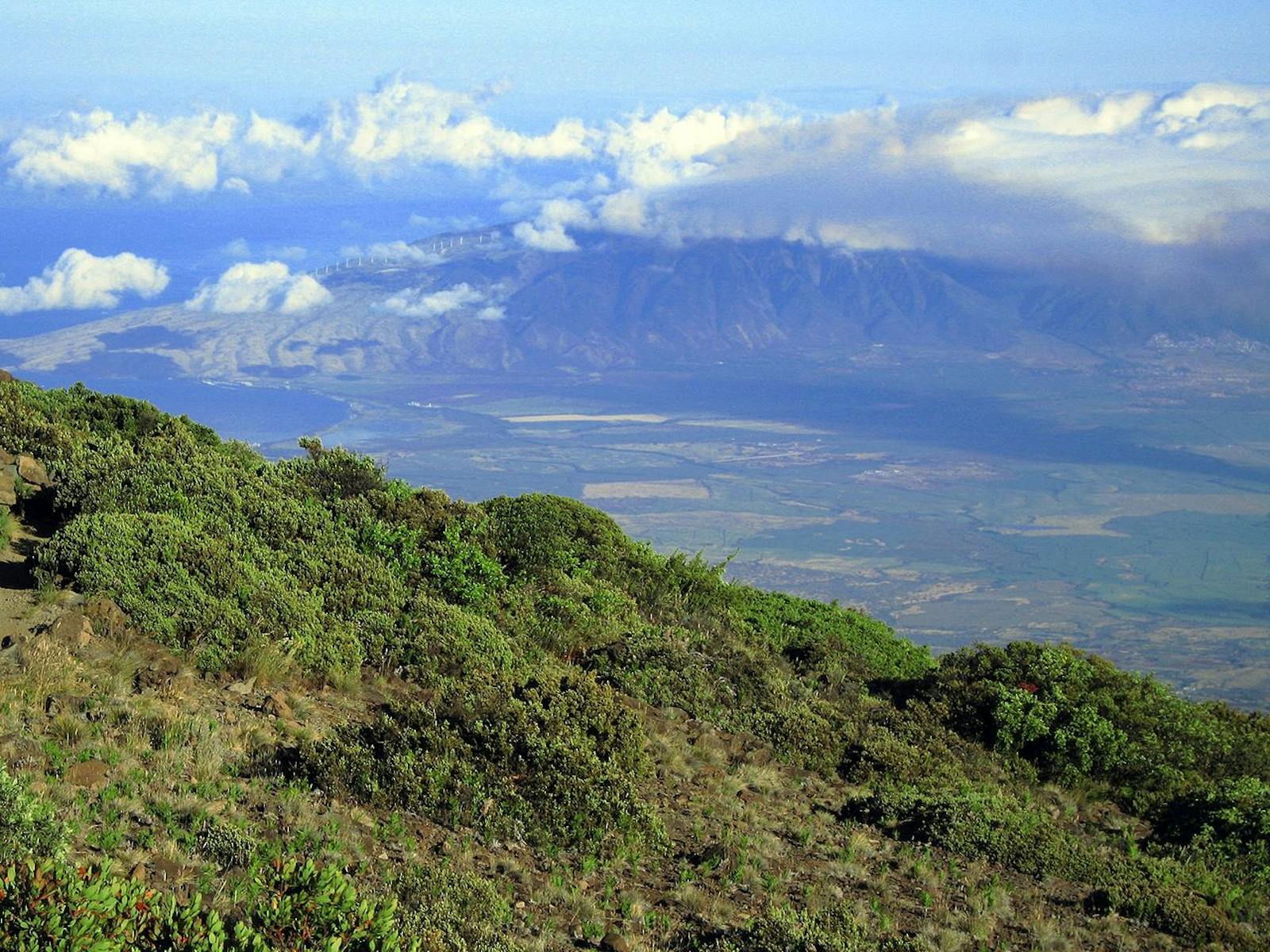Hawai'i Tropical High Shrublands
The ecoregion’s land area is provided in units of 1,000 hectares. The conservation target is the Global Safety Net (GSN1) area for the given ecoregion. The protection level indicates the percentage of the GSN goal that is currently protected on a scale of 0-10. N/A means data is not available at this time.
Bioregion: Hawai’i Tropical Islands (OC11)
Realm: Oceania
Ecoregion Size (1000 ha):
186
Ecoregion ID:
639
Conservation Target:
100%
Protection Level:
4
States: United States
Volcanic craters rising high above the clouds scattered with giant silver-green rosettes of the Hawai’ian silversword ('ahinahina) are among the most iconic landscapes of the islands. These spectacular plants have adapted to the dry, cold conditions that occur on the summits of the island’s tallest volcanoes: Haleakala (Maui), Mauna Loa (Hawai’i), and Mauna Kea (Hawai’i).
These alpine silverswords are part of an alliance of 30 related species of trees, shrubs, and herbs all descended from the arrival of a humble daisy-like tarweed from North America long ago, likely via sticky seeds stuck to a bird’s foot. Plants and animals that inhabit Hawai’i’s highest elevations are often representatives of alliances of closely-related species that have undergone broad diversification into open ecological niches in Hawai’i’s diverse ecosystems.

The flagship species of the Hawai'I Tropical High Shrublands ecoregion is the Hawai’ian silversword. Image credit: Creative Commons
The ecoregion’s alpine deserts, alpine grasslands, and sparse shrublands occur above 3,000 m up to 4,207 m and only support a few hardy drought- and cold-adapted species, including mosses, lichens, the silversword, Dubautia spp., Leptecophylla tameiameiae, Pellaea ternifolia, the grass Deschampsia nubigena, and the weiku bug that feeds on insects blown up from the lowlands. Downslope from the highest peaks (Mauna Kea, Mauna Loa, Hualalai, and Haleakala), from about 2,000 m to 3,000 m, are subalpine shrublands with species such as Chenopodium oahuense, Vaccinium reticulatum, Dubautia menziesii, and Santalum haleakalae.
Subalpine grasslands that also occur in this zone are dominated by tussock-forming species, such as Deschampsia nubigena, Eragrostis atropioides, and Panicum tenuifolium. Native bird species such as Hawai’ian nene goose, Hawai’ian dark-rumped petrels, and palila honeycreepers that specialize on mamane shrubs occur in these high shrublands.
Grazing and trampling by domestic and feral livestock, such as cattle, goats, mouflon, and sheep, pose a major threat to habitats in this ecoregion. The shallow roots of silverswords, for example, are easily damaged by animals and tourists alike. Wildfires and offroad vehicle damage also damage fragile vegetation and soils. The species that live in these challenging environments often are quite vulnerable to even a little disturbance. Silverswords are poached by plant collectors at times. Introduced plants outcompete native plant species, while Invasive ants prey on native invertebrates and seeds.
The important areas for conserving high shrublands include Leeward East Maui, Haleakala summit of Maui (protected), subalpine shrublands of Hualalai, alpine summits and surrounding subalpine shrublands of Mauna Loa and Manua Kea on Hawai’i, and the Pohakuloa-Saddle area of Hawai'i.
The priority conservation actions for the next decade are to: 1) control and eradicate domestic and feral livestock in the subalpine and alpine zones, particularly around the highly sensitive silversword populations; 2) fence alpine silversword populations, particularly around the endangered Mauna Kea subspecies populations to prevent grazing and trampling by feral livestock and tourists; and 3) control non-native livestock, offroad vehicles, and wildfires within more intact subalpine shrubland habitats representative of those distinct to different massifs (major islands, ranges, volcanoes) and habitat types.
Citations
- Kay EA. 1995. A Natural History of the Hawaiian Islands: Selected Readings II. University of Hawai’i Press, Honolulu. pp. 147.
- Mitchell C, C Ogura, DW Meadows, A Kane, L Strommer, S Fretz, D Leonard, A McClung. 2005. Hawaii’s Comprehensive Wildlife Conservation Strategy. Department of Land and Natural Resources. Honolulu, Hawai‘i. 722 pp.
- Mueller-Dombois D, FR Fosberg. 1998. Vegetation of the Tropical Pacific Islands. Springer-Verlag, New York.



